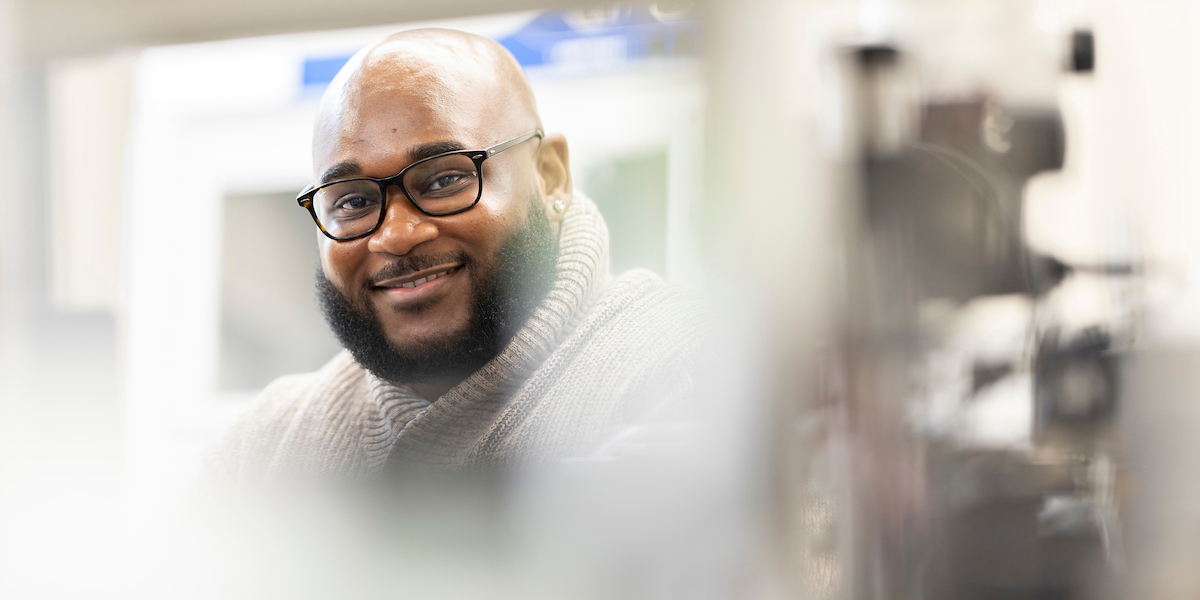Watson College PhD student leads research on flexible bioelectronics
Joab Dorsainvil, MS ’23, recently served as lead author for his first published paper

Joab Dorsainvil, MS ’23, earned his bachelor’s degree in mechanical engineering at SUNY Farmingdale — but when considering his options for graduate school, he chose a different path.
“Everyone in my family is in the biomedical field, whether it’s nursing or other types of medical care, so that’s always been close to home,” he said. “I wanted to bridge my expertise in mechanical engineering and 3D modeling, and to translate that into the biomedical discipline. It was a seamless transition — I can’t picture myself working in any other graduate lab but in a bioelectronics lab.”
Today, Dorsainvil is following up his master’s degree in biomedical engineering from Binghamton University’s Thomas J. Watson College of Engineering and Applied Science by pursuing a PhD. As part of Associate Professor Ahyeon Koh’s lab, he recently served as lead author for his first research paper published in the journal Advanced Materials Interfaces.
The study, which furthers Binghamton research on stretchable papertronics, is a collaboration with Koh and her former student, Matthew Brown, PhD ’22; as well as Professor Seokheun “Sean” Choi from the Department of Electrical and Computer Engineering and his PhD students, Zahra Rafiee and Anwar Elhadad. Koh and Choi received a $345,000 grant from the National Science Foundation in 2020 for the research.
The team created a nanofiber with a core of polydimethylsiloxane (PDMS) — a silicone-based and biologically inert material widely used for flexible and stretchable electronics — and a sheath of cellulose. They spun the fiber into a mesh and tested it for mechanically and biochemically compatible bioelectronics.
“I like to tell friends and family who aren’t in my field it’s like a mozzarella stick,” Dorsainvil said. “You have a crunchy, hard outer shell but the inside is more malleable. When you stretch the mozzarella stick, the outer shell does crack a little bit, However, the cellulose acetate sheath and the PDMS silicone core are both flexible and malleable without cracking.”
By including the silicone core, the amount of strain that can be applied while ensuring the bioelectronics still function rises from 2% to 4%, and the Binghamton team is exploring ways to optimize the new material to increase stability even further.
“It’s really opened the door for bridging the gap between soft bioelectronics that use stretchable substrates that are made to be worn on the skin compared to papertronics that are inexpensive, biocompatible and environmentally friendly,” Dorsainvil said. “There are a lot of great characteristics with paper — the only limitation is stretchability.”
Another possible improvement: Altering the formula so that the PDMS changes its characteristics from hydrophobic (water resistant) to hydrophilic (water absorbent), which could lead to important medical breakthroughs such as smart bandages that offer instant patient analysis to caregivers.
“PDMS is naturally hydrophobic, but if we add a block copolymer called polyethylene glycol — or PEG for short — it modifies the surface of PDMS,” Dorsainvil said. “If you were to cast it into a film and put a drop of water on it, it would spread across the surface nicely. This is great for skin applications like wound healing or sweat sensors, because PEG being hydrophilic means it will absorb wound exudate or sweat that can be analyzed further using electrodes. Additionally, PEG has been shown to have great antibacterial properties, which may have advantages in wound healing by minimizing the risk of infections to the wound area and reducing biofouling of electrode surfaces from biological fluids.”
Based on his summer 2023 internship and as part of his PhD dissertation, Dorsainvil will collaborate with the Air Force Research Lab to continue developing conductive fibrous soft bioelectronics.
“Joab is not only a brilliant scientist and engineer, but also an artist with advanced design skills and a teacher who mentors undergraduates,” Koh said. “We are very fortunate to have him in our lab.”
Looking back on all the hours of research that went into his first publication, Dorsainvil admitted he felt stunned yet excited when he learned it had been accepted.
“Once I saw that it was online, the first thing I did was to send it to close friends and family saying, ‘Do you remember the mozzarella stick?’ Then I advertised it online to social media,” he said. “Looking at it now, it still feels weird. This was three years of my life summed up in an 11-page paper. It’s something that I’m grateful for and appreciative of, and I look forward to further expanding my research in this field.”

